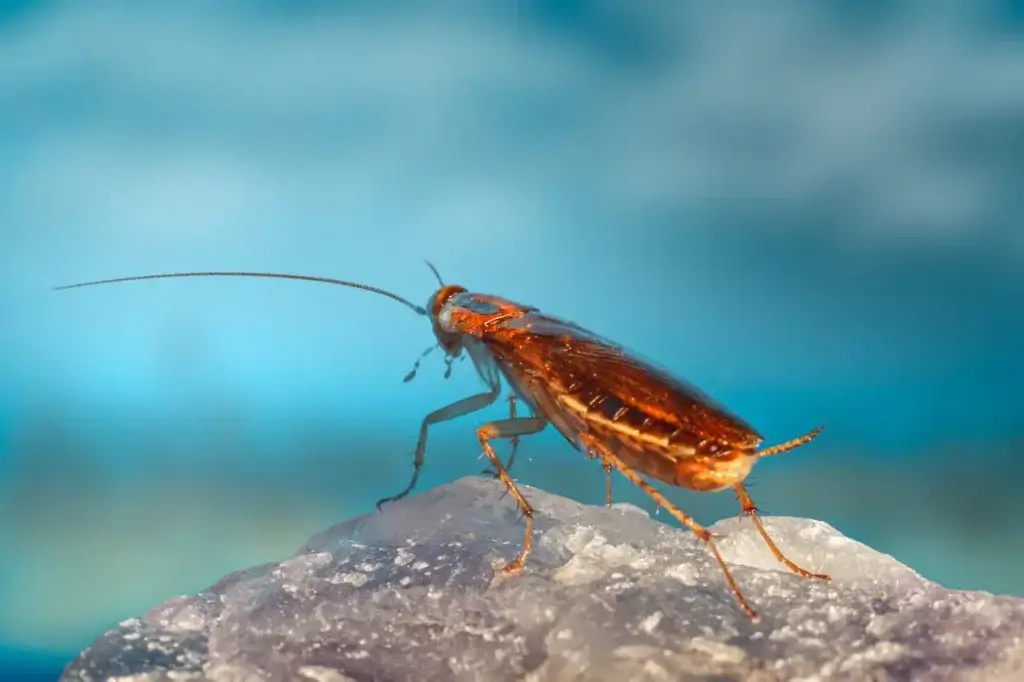
Waterbug or Cockroach: How to Tell Cockroaches and Waterbugs Apart
Be it a waterbug or cockroach, you’re most likely alarmed when you see a big brown beetle-like critter scurrying across your patio, or out from under the sink. While these two can look pretty similar at first glance, cockroaches and waterbugs have some distinct characteristics that set them apart from each other—and knowing the difference can make it easier to get rid of them as soon as possible, so you don’t have to worry about what might be lurking in your kitchen or bathroom.
Let's learn whether you're dealing with a waterbug or cockroach problem - and what you can do to about either infestation!

Table of Contents
What Is a Waterbug?
The term "waterbug" is used to refer to a few different types of insects, and the meaning may vary based on the area of the country or world you find yourself in. In North Carolina, “waterbug” is usually referring to one of the following:
True Waterbugs
In scientific terms, these waterbugs are those that belong to the order Hemiptera, or “true bugs”. There are 40,000 species of true bugs in the world, each of which has two pairs of wings, and mouthparts that can pinch, bite, or suck, depending on the bug. Along with water bugs, this order also includes bugs like bed bugs, water scorpions, and cicadas.
True waterbugs have long, slender bodies and are equipped with piercing-sucking mouthparts, which they use to feed on other small aquatic organisms. They are adapted to life in freshwater habitats like ponds, streams, and marshes.
Giant Waterbugs
The term "waterbug" is sometimes used more specifically to describe insects from the family Belostomatidae, also known as giant waterbugs. These insects can be found in various freshwater habitats, and they are typically larger than other water bugs; the largest can be as long as 5 inches.
Known for their powerful forelimbs, they can quickly catch and consume prey, including small fish and other insects.
In some cases, people might refer to certain large species of cockroaches as waterbugs, especially those that prefer damp environments like the oriental cockroach and the American cockroach. This can lead to confusion, as true water bugs and cockroaches are actually from entirely different insect groups.
Still not sure whether you have a waterbug or cockroach infestation? Keep reading:
Cockroach vs. Waterbug: What’s the Difference
A waterbug or cockroach are two insects that often share a common habitat and can cause concern for homeowners. So when it comes to a cockroach vs waterbug, these pests have a few traits that set them apart from each other.
Waterbug or Cockroach: Physical Appearance
The easiest way to tell the difference between a waterbug or cockroach is by their physical characteristics. Cockroaches are brown or black, with flattened oval bodies and long antennae. They have wings, although not all species can fly.
On the other hand, waterbugs have more elongated bodies and may appear more gray or brown. They are typically larger, with some species reaching up to five inches in length. Waterbugs are also known for their distinctive oar-shaped hind legs, which aid them in swimming.
Waterbug or Cockroach: Preferred Habitats
While both cockroaches and waterbugs thrive in moist environments, cockroaches are more adaptable and can be found in various settings, including kitchens, bathrooms, and basements. They tend to seek out warmth and darkness.
Waterbugs, as their name suggests, are more closely associated with water sources like ponds, streams, and sewage systems.
Waterbug or Cockroach: Behavior
When it comes to a waterbug or cockroach, they have similar behaviors.
Cockroaches are nocturnal creatures, preferring to forage for food at night. They are opportunistic feeders and can consume a wide range of organic matter.
Waterbugs, though also nocturnal, tend to be more active in water than cockroaches. They are predators who prefer to hunt rather than forage, feeding on small aquatic organisms and insects. They use their specialized mouthparts to capture and consume prey.
Oriental Cockroach vs. Waterbug
The most common source of confusion in the cockroach vs. waterbug conversation comes from one particular kind of roach: The Oriental cockroach. Let’s take a closer look at where the similarities start and stop for these two pests so you can better identify a waterbug or cockroach.
Oriental Cockroach
The Oriental cockroach, which has even been commonly referred to as "water bug" in some regions (confusingly enough), is a large, dark brown to black insect. Adult females typically grow up to 1 inch in length, while males are slightly smaller. Both sexes have wings, but they are short and non-functional. Despite their wings, Oriental cockroaches are not strong fliers and generally prefer to crawl.
This cockroach thrives in damp and dark environments. It is commonly found in basements, crawl spaces, drains, and sewers, where humidity levels are highest. Oriental cockroaches are also nocturnal creatures, preferring to emerge at night to forage for food. They are scavengers and omnivores, consuming a variety of organic matter.
Waterbugs
These insects have an elongated body, prominent front legs for grasping prey, and are often larger than the Oriental cockroach.
As we mentioned before, true water bugs are closely associated with aquatic environments such as ponds, streams, and marshes. They are excellent swimmers, using their specialized hind legs to navigate through water. Still, some species may be found indoors, especially if there are nearby water sources like leaky pipes or standing water.
They are predatory insects, feeding on small aquatic organisms and insects. While they may venture into homes, their primary habitat is near water sources. If found indoors, it is often due to a water source somewhere nearby.
Why Do People Get Waterbugs and Cockroaches Confused?
Both Oriental cockroaches and certain types of true water bugs are colloquially referred to as "waterbugs" in some regions. This shared nickname is one of the main sources of all this confusion, as people might use the term without distinguishing between the different insects.
Plus, Oriental cockroaches and some waterbugs do share similar characteristics, such as a dark brown to black coloration and a relatively large size. Both Oriental cockroaches and waterbugs are associated with environments containing moisture, and both are nocturnal. This shared behavior, along with their similar appearances, can make it challenging to tell the difference, especially if you spot one in low-light conditions.
When identifying a waterbug or cockroach, many people can get easily confused. Most are not well-versed in entomology or the specific characteristics of different insect species. Lack of knowledge about the distinct features and behaviors of Oriental cockroaches and waterbugs has led to the common misconception that they are one and the same.
What Kills Waterbugs?
Are you dealing with a waterbug or cockroach? Knowing which insect is in your home will help with treatment. Waterbugs are adaptable insects, which means they typically require a comprehensive approach to control and eradicate them from a home.
Insecticides
Identify areas where waterbugs are prevalent, both inside and outside your home. Apply insecticides strategically in these areas, focusing on entry points, harborage areas, and places with high moisture content. Common indoor areas include bathrooms, kitchens, and basements, while outdoor spaces near water sources should also be treated.
When using insecticides, it is crucial to choose products specifically formulated for waterbugs. These insecticides often contain ingredients that are effective against aquatic pests. Always read and follow the product instructions carefully to ensure safe and effective application.
Cleaning and Drying
Actively search for and repair any leaks in plumbing, roofs, or windows. Waterbugs are attracted to damp environments, and addressing leaks denies them the moisture they need to thrive. Regularly inspect and maintain water fixtures, ensuring they remain in good condition.
You should also enhance ventilation in areas prone to dampness. Proper air circulation can help reduce humidity levels, making it less conducive for waterbugs. Consider installing exhaust fans, ensuring they are functional and vented to the outside, especially in bathrooms and kitchens.
Finally, use dehumidifiers to extract excess moisture from the air. This is particularly effective in basements and other areas where humidity tends to be higher. Keep humidity levels below 50% to discourage waterbug infestations.
Natural Predators
Introduce natural predators that feed on waterbugs, like dragonfly nymphs, and specific fish species, such as goldfish or guppies. These can be effective in controlling waterbug populations in outdoor water sources without the need for any chemicals or insecticides.
Professional Pest Control
If needed, pest control professionals can conduct a thorough assessment of the waterbug infestation. They will identify the species, assess the severity, and determine the most effective course of action. Professionals can provide tailored solutions based on the specific conditions of your home.
Professional pest control services also often include preventive measures to discourage future infestations. This may involve sealing entry points, implementing habitat modifications, and providing ongoing monitoring to ensure the effectiveness of the control measures.
What to Do About Waterbugs in House
If you suspect you have waterbugs in your home, here’s your plan of action.
Identify the Source
Start with a detailed inspection of your home to identify the source of the waterbug infestation. Check for leaks in plumbing, roof, and windows, as well as any areas with standing water. Understanding the root cause is vital for effective pest management.
Determine if there are specific areas with high humidity or moisture. Waterbugs thrive in damp environments, and addressing these conditions will disrupt their habitat and discourage further infestation.
Eliminate Standing Water
Immediately address any identified leaks. This includes fixing plumbing issues, repairing roof leaks, and ensuring windows and doors are properly sealed. A quick response to leaks prevents waterbugs from finding the moisture they need for survival.
Regularly flush drains with hot water and use appropriate drain cleaners to prevent organic matter buildup, which can attract waterbugs.
Then, extend your inspection to the exterior of your home. Check for any outdoor sources of standing water, such as clogged gutters, stagnant pools, or containers collecting rainwater. Eliminate these sources to discourage waterbugs from entering your home.
Seal Entry Points
After your inspection, seal cracks, gaps, and openings using caulk or sealant. Pay special attention to areas around windows, doors, pipes, and utility lines. This not only prevents waterbugs but also acts as a barrier against other pests.
While doing so, ensure that doors and windows have proper weather stripping. This not only helps with insulation but also seals gaps that could serve as entry points for waterbugs.
Good Hygiene
Maintaining a clean and sanitary living space is key to keeping waterbugs from coming back. Regularly clean and sanitize surfaces, especially in kitchens and bathrooms, which are common areas for waterbug infestations. This removes potential food sources and discourages their presence.
Which is More Dangerous: Waterbug or Cockroach?
Are you dealing with a waterbug or cockroach problem? Both waterbugs and cockroaches can pose health risks, but the level of danger they present may vary depending on the species and specific circumstances. Generally, cockroaches are considered more problematic for human health than waterbugs.
The Danger of Cockroaches
Cockroaches are known carriers of various pathogens and bacteria. They can pick up germs on their legs and bodies as they crawl through unsanitary areas, such as trash, sewage, and decaying matter. When they come into contact with food preparation surfaces or food items, they can transfer these pathogens, potentially causing foodborne illnesses.
Even cockroach droppings, shed skins, and saliva are dangerous, as they contain allergens that can trigger asthma and allergic reactions in some. This is a significant concern, especially in homes where some members of the household may be dealing with respiratory issues.
Cockroaches are prolific breeders, and their population can grow quickly. A small infestation can escalate into a more significant problem in a short amount of time.
The Danger of Waterbugs
While some species of waterbugs are known to have painful bites, the bites are generally not dangerous. They can cause some discomfort and irritation, but in most cases they will not require medical attention.
Waterbugs often inhabit aquatic environments, and if they come into contact with water sources used by humans, there is a risk of contamination. However, this is more of a concern in outdoor water bodies rather than indoor infestations.
Final Word: Waterbug or Cockroach
Understanding the differences between cockroaches and waterbugs is crucial for effective pest control. Knowing whether you're dealing with a waterbug or cockroach will help you with treatment. By implementing preventive measures and addressing infestations promptly, you can create a happier, healthier, and more comfortable living environment.
If you’re dealing with a waterbug or cockroach problem, seeking professional assistance may be the most effective solution. A-1 Pest Control has been providing peace of mind to North Carolina homeowners for more than 50 years, with the latest and greatest in pest control knowledge and equipment. Sign up for a home pest control plan today. Stop wondering whether you have a waterbug or cockroach problem - call an exterminator today!
For more information, or to schedule your pest inspection and estimate, call us today at 828-481-9140.
